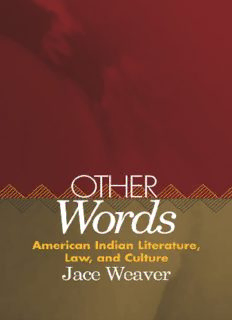
Other Words: American Indian Literature, Law, and Culture (American Indian Literature and Critical Studies Series) PDF
Preview Other Words: American Indian Literature, Law, and Culture (American Indian Literature and Critical Studies Series)
O W THER ORDS American Indian Literature and Critical Studies Series Gerald Vizenor, General Editor This page intentionally left blank O W THER ORDS American Indian Literature, Law, and Culture BYJACEWEAVER UNIVERSITYOFOKLAHOMAPRESS: NORMAN Also by Jace Weaver Then to the Rock Let Me Fly: Luther Bohanon and Judicial Activism(Norman, 1993) Defending Mother Earth: Native American Perspectives on Environmental Jus- tice(Maryknoll, NY, 1996) That the People Might Live: Native American Literatures and Native American Community (New York, 1997) Native American Religious Identity: Unforgotten Gods (Maryknoll, NY, 1998) American Journey: The Native American Experience(Detroit, 1998) Library of Congress Cataloging-in-Publication Data Weaver, Jace, 1957– Other words :American Indian literature, law, and culture / by Jace Weaver. p. cm. — (American Indian literature and critical studies series ; v. 39) Includes bibliographical references (p. ) and index. ISBN 0–8061–3352–X (alk. paper) 1. Indians of North America—Social conditions. 2. Indians of North America—Legal status, laws, etc. 3. Indians in literature. I. Title. II. Series. E98.S67 W43 2001 973.0497—dc21 2001027468 Other Words: American Indian Literature, Law, and Cultureis Volume 39 in the Amer- ican Indian Literature and Critical Studies Series. The paper in this book meets the guidelines for permanence and durability of the Committee on Production Guidelines for Book Longevity of the Council on Library Resources, Inc. ∞ Copyright © 2001 by Jace Weaver. All rights reserved. Published by the University of Oklahoma Press, Norman, Publishing Division of the University. Manufactured in the U.S.A. 1 2 3 4 5 6 7 8 9 10 Blue The sun crowns the horizon mountains Like a child being pushed from its mother’s womb. Born out of the earth this day as any other, Aceaseless cycle of birth, death, and rebirth. The creatures of the night Have packed away their voices. And those of the day have yet to find their throats. It is the time the French call “l’heure bleue,” The blue hour. But it is not an hour but a moment, an instant, Suspended between night and dawn. I stand stock-still in the California air. Afraid to disturb the fragile communion, Surely the same felt by our ancestors in the sheer silence as they greeted the new day. Or by Elijah as he recognized the still small voice of his god. Abird calls out, As indifferent to my presence as he would be to my absence. The blue hour is gone until tomorrow. JACEWEAVER This page intentionally left blank C ONTENTS “Blue” v Preface ix Part One. LITERATURE 1 1. In Other’s Words: Literature and Community 3 2. Trickster among the Wordies: The Work of Gerald Vizenor 53 3. Venus on the Half-Shell? Why Not? 59 4. Remnants of the First Earth: AReview 66 5. An Übermensch among the Apache: Or, Karl May’s Tour of the Grand Teutons 69 6. Clowns and Villains: American Natives and the American Musical 91 7. Innocents Abroad: Or, Smilla Has a Sense of Snow, but Our Kanawakes Are in Egypt 117 8. Hell and Highwater 130 9. Original Simplicities and Present Complexities: Reinhold Niebuhr, Ethnocentrism, and the Myth of American Exceptionalism 140 Part Two. LAW 155 10. Indian Presence with No Indians Present: NAGPRAand Its Discontents 157 viii CONTENTS 11. Losing My Religion: Native American Traditions and American Religious Freedom 175 12. Triangulated Power and the Environment: Tribes, the Federal Government, and the States 189 13. Scaling Ríos Montt: Indigenous Peoples, International Human Rights, and the PinochetCase 201 Part Three. CULTURE 227 14. It Came from Outer Space: Of Museums, Meteorites, and Messengers of the Gods 229 15. Native Reformation in Indian Country? Forging a Relevant Spiritual Identity among Indian Christians 237 16. ABiblical Paradigm for Native Liberation 242 17. Trickster: The Sacred Fool 246 18. Reaching beyond Language:Native American Eschatology and Apocalyptic Messianism 258 19. From I-Hermeneutics to We-Hermeneutics: Native Americans and the Post-Colonial 280 Notes 305 Bibliography 357 Index 375 P REFACE Almost ten years ago, I became what I like to term a “recovering lawyer.” I left the daily practice of law to pursue a Ph.D. in religious studies. Nevertheless, the urge to “pick up” the law has neverleft me and remains something I struggle against one day at a time, sometimes successfully, sometimes less so. Well-meaning friends contact me to help with briefs on sacred sites and religious freedom, call me about the rights of prison- ers to have access to traditional practices, even importune me to partici- pate in a small criminal case on a western reservation. It has become clear to me that being a lawyer is like being a cannibal: Eat one arm and peo- ple will call you a cannibal for life. Ask Alferd Packer. This is, to an extent, however, natural. The hand of congressional plenary power still rests heavy on American Natives. Aside from his or her relation to family, clan, or tribal nation, an Indian’s most significant relationship is with the federal government. I still teach federal Indian and constitutional law, and the law continues to be an important part of my scholarship. So, as a professor of Native American Studies, my shackles to the law remain firmly in place and always will. Native American Studies is by its nature two things, comparative and interdisciplinary. Though a given scholar’s work may focus on a particu- lar tribe, the field itself must take account of probably six hundred extant tribal traditions and eight major language families in the United States alone. Acomparative approach is thus a simple reality. And so is inter- disciplinarity. Asingle piece of scholarship may cut across not only law
Description: